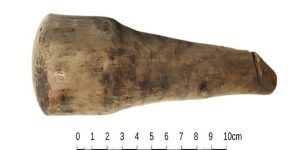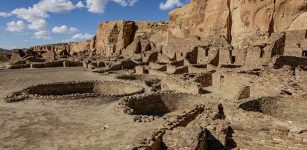Advanced Technology Of The Ancients: Artificial Platforms Of Mighty Nan Madol
A. Sutherland - AncientPages.com - Two very remarkable islands - Kosrae and Pohnpei ("upon a stone altar") - can be found in the Caroline Islands, a widely scattered archipelago located in the western Pacific Ocean, to the north of New Guinea and more than 1,500 miles to the east of the Philippines.
The ruins of Nan Madol on Pohnpei Island. Image credit: NOAA - Public Domain
These two places are full of mysteries, particularly because of bizarre remains of ancient architecture, in the form of very old megalithic cities, of which origin no one is able to guess."
Those, who do not invalidate the myths and legends of the ancients, can ponder over some interesting legends and myths. One of them says that "magic powers" were used to transport the logs from a far-away location, by making them fly and yet another legend supports the latter, saying about a mighty "magician" who made the logs fly towards Nan Madol, where the city was constructed and a firebreathing dragon became its symbol.
Who was interested in building two of the Pacific's largest basalt cities?
How were the huge, very heavy basalt columns and logs quarried and transported? In what manner were the walls constructed so high?
Who built the megalithic complexes, when and why were they built on both islands, at all?
Legends say that giants once lived on Ponape and archaeologists have discovered human bones belonging to people much taller than the natives of the region. They had at their disposal the physical means to carry the heavy basalt logs and built walls as high as 50 feet and as thick as 17 feet.
The inhabitants of both islands have absolutely no idea about their origin because the ruins were already in place at the time of the arrival of the early settlers.
The ruins of Nan Madol in Pohnpei. Image credit: CT Snow - CC BY 2.0
The ruins on the island of Kosrae are known among the white people as the "city of kings, and among the natives as "Insaru". They were built of huge hexagonal stone blocks and many of them have a mass between 30 to 60 tons, and according to a professional opinion of civil engineers and architects, the hexagonal blocks must be cut with mathematical exactness in all their dimensions.
A survey conducted on the Lelu Stone Ruins of Kosrae since 1978, showed west of the hill was artificial — a 0.6-1.0 meter deep fill of coral and basalt stone, with man-made extensions of the island, which bravely resist tropical cyclones of the Pacific Ocean.
Today, the ruined city on Kosrae has been reclaimed by the jungle and it is not visited so frequently as neighboring Nan Madol on Ponape. Nan Madol is a strange place, built into the ocean (!) which means that it is not located on the dry land of Ponape Island.
The origin of the basalt building stones used to construct Nan Madol is old. Basalt was most probably transported from only one far-away location on the opposite side of the island to the coral reef.
As no traces of prehistoric machines were found., archaeologists speculated that the builders used rafts. However, all attempts to use rafts to transport heavy construction material - failed because heavy, iron rich hard rock immediately sank due to its weight.
"Immense columns of prismatic basalt rock, quarried from various locations around the island, formed high-walled rectangular enclosures for the coral rubble used as fill for the islets' floor. Built over an extended period of time, Nan Madol eventually came to consist of ninety-two artificial islets that covered an area of 200 acres.. The most spectacular of the complex's structures reached a height of 25 feet..." (D.L. Hanlon)
It is estimated that at least 250 million tons of basalt logs are needed to construct a city, the size of Nan Madol and relatively long distance that separates Ponape island from the larger landmasses makes the history of the ruins fascinating.
At the peak of the last glacial maximum, Ponape Island was situated over a thousand kilometers to the north from the eastern edge of the Peninsula and the chain of islands, which today, partly form the Solomon Archipelago.
But the truth is that nobody knows when the megalithic complex was built and this is one of the biggest mysteries of archaeology.
All that's left of the earlier prehistoric city was named by the natives as "Nan Madol" and means "spaces between". The name may refer to an extended system of channels but it can mean something completely different. According to some opinions, Nan Madol could have been some religious and ceremonial center, but... was it?
"No site in Oceania surpasses the dramatic beauty of ancient Nan Madol... situated on the coast of Pohnpei, the elite administrative and ceremonial center grew, flourished and declined during the centuries preceding Western contact..." (W. N. Morgan)
It is a magnificent complex of ninety-two artificial islets interconnected by a network of waterways and according to Dr. Ayres, Professor of Anthropology at the University of Oregon and a researcher at Nan Madol, with extensive experience in Pacific archaeology, "to withstand time and the sea, the artificial platforms were built in a staggeringly laborious process."
"Multiton basalt columns, formed by volcanic activity, were stacked horizontally, log-cabin style, to form outer walls..."
Written by – A. Sutherland - AncientPages.com Senior Staff Writer
Copyright © AncientPages.com All rights reserved. This material may not be published, broadcast, rewritten or redistributed in whole or part without the express written permission of AncientPages.com
Expand for referencesReferences:
Ehrlich P., Hadley M., Nan Madol: Spaces on the Reef of Heaven
Morgan, William N. Prehistoric Architecture in Micronesia
More From Ancient Pages
-
 Tragic Curse Of Kaskaskia – The First Capital Of Illinois
Featured Stories | Jan 9, 2020
Tragic Curse Of Kaskaskia – The First Capital Of Illinois
Featured Stories | Jan 9, 2020 -
 Impressive 2,700-Year-Old Farmhouse And 1,500-Year-Old Monastery Uncovered In Rosh Ha-‘Ayin
Archaeology | Dec 30, 2015
Impressive 2,700-Year-Old Farmhouse And 1,500-Year-Old Monastery Uncovered In Rosh Ha-‘Ayin
Archaeology | Dec 30, 2015 -
 Bertrand du Guesclin: ‘Eagle Of Brittany’ Brave, French Commander And His Clash With Sir Thomas Of Canterbury
Featured Stories | May 1, 2023
Bertrand du Guesclin: ‘Eagle Of Brittany’ Brave, French Commander And His Clash With Sir Thomas Of Canterbury
Featured Stories | May 1, 2023 -
 Mystery Of The British Pompeii Deepens – Bronze Age Settlement Destroyed By Dramatic Fire
Archaeology | Jun 23, 2019
Mystery Of The British Pompeii Deepens – Bronze Age Settlement Destroyed By Dramatic Fire
Archaeology | Jun 23, 2019 -
 Artifacts From Shakhi Kora Reveal The Rejection Of Early Centralized Governance In Ancient Mesopotamia
Archaeology | Dec 9, 2024
Artifacts From Shakhi Kora Reveal The Rejection Of Early Centralized Governance In Ancient Mesopotamia
Archaeology | Dec 9, 2024 -
 ‘Impossible’ Ancient Knowledge Of The Gods’ Star – Mysterious Beings – Part 2
Ancient Mysteries | Sep 4, 2021
‘Impossible’ Ancient Knowledge Of The Gods’ Star – Mysterious Beings – Part 2
Ancient Mysteries | Sep 4, 2021 -
 Remnants Of A Royal Rest House That Served As A Temporary Residence For Pharaoh Thutmose III
Archaeology | May 9, 2024
Remnants Of A Royal Rest House That Served As A Temporary Residence For Pharaoh Thutmose III
Archaeology | May 9, 2024 -
 Pilot Mountain Is Home To A Mysterious Underground Civilization – Cherokee Legend Tells
Featured Stories | Apr 30, 2021
Pilot Mountain Is Home To A Mysterious Underground Civilization – Cherokee Legend Tells
Featured Stories | Apr 30, 2021 -
 Puzzling Construction Of Unique Sunken Ship From The 17th Century Examined
Archaeology | Jul 28, 2022
Puzzling Construction Of Unique Sunken Ship From The 17th Century Examined
Archaeology | Jul 28, 2022 -
 On This Day In History: 150 Highly-Trained Swiss Guards Entered Vatican For The First Time – On Jan 22, 1506
News | Jan 22, 2017
On This Day In History: 150 Highly-Trained Swiss Guards Entered Vatican For The First Time – On Jan 22, 1506
News | Jan 22, 2017 -
 Obatala ‘King Of The White Cloth’ And Creation Story Of Yoruba People
African Mythology | Jan 9, 2021
Obatala ‘King Of The White Cloth’ And Creation Story Of Yoruba People
African Mythology | Jan 9, 2021 -
 Solving The Mystery Of Westminster Abbey’s Lost Chapel And Disemboweled Saint – New Evidence
Archaeology | Dec 1, 2022
Solving The Mystery Of Westminster Abbey’s Lost Chapel And Disemboweled Saint – New Evidence
Archaeology | Dec 1, 2022 -
 Unique Roman Artifact Discovered At Vindolanda Was More Than A Good Luck Charm
Archaeology | Feb 20, 2023
Unique Roman Artifact Discovered At Vindolanda Was More Than A Good Luck Charm
Archaeology | Feb 20, 2023 -
 Social Tensions Among Ancient Pueblo Societies Contributed To Their Downfall – Not Only Drought
Archaeology | Apr 27, 2021
Social Tensions Among Ancient Pueblo Societies Contributed To Their Downfall – Not Only Drought
Archaeology | Apr 27, 2021 -
 Unique Flagship ‘Gribshunden’: Spectacular Discoveries
Archaeology | Oct 2, 2019
Unique Flagship ‘Gribshunden’: Spectacular Discoveries
Archaeology | Oct 2, 2019 -
 Ginnungagap From Which The World, Gods, Humanity And All Life Emerged In Norse Beliefs
Myths & Legends | Dec 11, 2024
Ginnungagap From Which The World, Gods, Humanity And All Life Emerged In Norse Beliefs
Myths & Legends | Dec 11, 2024 -
 Mysterious Tunnel Found Under Saxon Palace Ruins In Warsaw, Poland
Archaeology | Sep 14, 2023
Mysterious Tunnel Found Under Saxon Palace Ruins In Warsaw, Poland
Archaeology | Sep 14, 2023 -
 Comet Strike 13,000 Years Ago May Have Changed Human Civilization
Archaeology | Jul 6, 2021
Comet Strike 13,000 Years Ago May Have Changed Human Civilization
Archaeology | Jul 6, 2021 -
 Aboriginal ‘Memories’ Of Australia’s Coastline Go Back More Than 7,000 Years
Civilizations | Sep 30, 2015
Aboriginal ‘Memories’ Of Australia’s Coastline Go Back More Than 7,000 Years
Civilizations | Sep 30, 2015 -
 Middle Iron Age And Roman Period Buildings And Relics Discovered In Bedfordshire, UK
Archaeology | Feb 27, 2022
Middle Iron Age And Roman Period Buildings And Relics Discovered In Bedfordshire, UK
Archaeology | Feb 27, 2022


